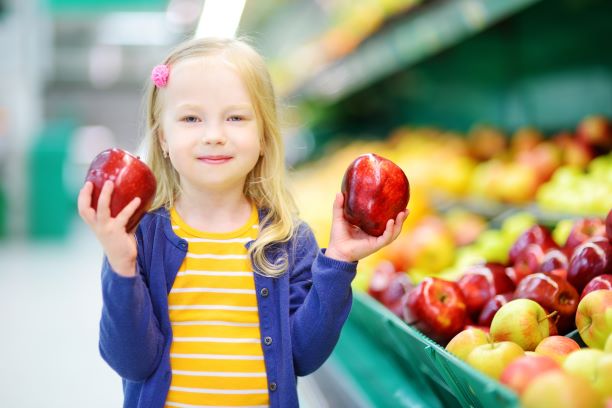Nutrition for Children with Chronic Kidney Disease
On this page:
- Why is nutrition important for children with chronic kidney disease?
- Why are calories important?
- Why is knowing about protein important?
- Why is knowing about sodium important?
- Why is knowing about potassium important?
- Why is knowing about phosphorus important?
- Should your child take vitamin and mineral supplements?
- Why is keeping track of how much liquid your child consumes important?
- What are some special problems for infants with CKD?
- Understanding lab reports and making healthy food choices for your child with CKD
- Clinical Trials for Children with CKD
Why is nutrition important for children with chronic kidney disease?
Eating the right foods in the right amounts may improve your child’s growth, help your child feel better, and prevent or delay health problems from chronic kidney disease (CKD).
Healthy kidneys balance the salts and minerals—such as calcium, phosphorus, sodium, and potassium—in blood. When your child has kidney disease, his or her kidneys are damaged and can’t filter blood the way they should. What your child eats and drinks can help maintain a healthy balance of salts and minerals in his or her body.
Eating right can also make your child’s CKD medicines work better.
Your child’s health care team will work with you to create an eating plan with the right foods and nutrients in the right amounts for your child to grow properly. The team may suggest changes in both the amount and types of food your child needs as he or she gets older or if your child’s kidney disease gets worse. Learning about nutrients in food will help you understand what changes you need to make to your child’s diet. You should always talk with the health care team before making any major changes to your child’s diet.
 Your child’s health care team will work with you to create the right eating plan.
Your child’s health care team will work with you to create the right eating plan.Why are calories important?
Food provides energy your child needs to grow and be active. Children with CKD tend to avoid eating because they don’t feel hungry. Talk with your child’s kidney specialist or dietitian to make sure your child is getting enough calories for proper growth and to fight infections.
Children’s calorie needs change depending on their age, height, and weight. Your child’s health care team will determine your child’s daily calorie needs, which will change as your child gets older.
To make sure your child is growing properly, his or her health care professional will compare your child’s height and weight against growth charts that show the normal ranges of growth for children by age. If your child is not growing well, the health care team can suggest healthy ways to add calories to your child’s diet. Feeding tubes—thin, flexible tubes that carry liquid food into the stomach or small intestine —are often used for infants and, occasionally, situations arise in which older children and teenagers may also benefit from them.
Why is knowing about protein important?
Protein is an important part of any diet. As your child’s body uses protein, it produces waste that the kidneys must remove from the blood. Too much protein can cause waste to build up in your child’s blood.
However, in children with CKD, too little protein can prevent them from growing normally and getting important nutrients. The goal is for children to eat enough protein to grow but to avoid excessive amounts of protein. The table below shows some common sources of animal and plant proteins.
Sources of protein
Animal-protein foods
- Dairy products, such as milk, yogurt, cheese
- Eggs
- Fish
- Meat, such as pork, beef, chicken, turkey, duck
Plant-protein foods
High protein
- Beans, lentils, peas
- Nuts and nut spreads, such as almond butter, peanut butter, soy nut butter
- Soy foods, such as soy milk, tofu
- Sunflower seeds
Low protein
- Bread, tortillas
- Oatmeal, grits, cereals
- Pasta, noodles, rice
- Rice milk (not enriched)
Talk with a dietitian about how much protein is in your child’s eating plan and where the protein comes from. A dietitian can suggest dietary changes to help meet your child’s protein needs.
Children on dialysis
Children on dialysis need to eat somewhat more protein because the dialysis treatment removes some protein from the blood. The amount of protein removed from the blood depends on the type of dialysis treatment.
Your child’s protein needs will change over time. A dietitian can work with you and your child to adapt meal plans to your child’s changing needs.
Why is knowing about sodium important?
Sodium is a part of salt. Different children with CKD have very different sodium needs. In some children with CKD, too little sodium can lead to dehydration and poor weight gain. In other children, too much sodium may cause high blood pressure. What your child eats and drinks can help control the amount of sodium in his or her diet.
The amount of sodium your child needs will depend on the type of CKD your child has and how severe it is, your child’s age, and other factors. You may need either to limit or add sodium to your child’s diet. Talk with your child’s health care team about how much sodium your child should have.
If your child’s health care team suggests lowering the amount of sodium in his or her diet, you can help your child by
- buying fresh fruits and vegetables
- choosing unprocessed meats instead of processed foods
- cooking from scratch
- using spices, herbs, and salt-free seasonings instead of salt
- looking for products labeled "sodium free" or "low sodium"
- draining and rinsing canned foods to removed salt
Higher- and lower-sodium foods
Foods higher in sodium include
- bacon, corned beef, ham, hot dogs, luncheon meats, sausage
- bouillon, canned soups, instant soups, ramen noodle packages
- boxed mixes, such as hamburger meals and pancake mix
- canned and pickled vegetables, vegetable juice
- canned beans, chicken, fish, meat
- canned tomato products, including juice
- cottage cheese
- frozen meals
- frozen vegetables with sauce
- olives, pickles, relish
- pretzels, chips, crackers, salted nuts
- ready-to-eat boxed meals and side dishes
- salad dressings, bottled sauces, marinades
- salt and salt seasonings, such as garlic salt
- seasoning mix, sauce packets
- some ready-to-eat cereals, baked goods, breads
- soy sauce
Foods lower in sodium include
- air-popped popcorn
- cooked cereal without added salt
- fresh meat, poultry, seafood
- fresh or frozen fruits and vegetables
- low- and reduced-sodium frozen dinners, peanut butter, salad dressings
- low-fat, low-sodium cheese
- rice, noodles
- unsalted nuts
Why is knowing about potassium important?
In some children with CKD, the kidneys do a poor job of removing potassium from the blood, and blood potassium levels can become very high. Too little or too much potassium can cause heart and muscle problems. Children with CKD should have their blood checked regularly to make sure their potassium levels are normal. Your child’s food and drink choices can affect his or her potassium level. Talk with your child’s health care team about how much potassium your child should have.
If the health care team suggests your child needs to lower the amount of potassium in his or her diet, you can help your child by
- selecting fruits and vegetables that are lower in potassium
- draining canned fruits and vegetables and throwing out the liquid, which is often high in potassium
- using spices and herbs instead of salt substitutes, which can be very high in potassium
- talking with your child's dietitian about choosing foods your child likes that have the right amount of potassium
 Choose fruits and vegetables lower in potassium.
Choose fruits and vegetables lower in potassium.
Higher- and lower-potassium foods
In the lists below, potassium level is based on one serving. One serving of fruit is one small piece; ½ cup fresh, canned, or cooked fruit; ¼ cup dried fruit; or ½ cup juice. One serving of vegetables is ½ cup fresh or cooked vegetables, 1 cup leafy vegetables, or ½ cup juice.
Foods higher in potassium include
- fruits
- apricots (fresh)
- bananas
- cantaloupe
- dates
- kiwi
- nectarines
- oranges/orange juice
- prunes/prune juice
- raisins
- vegetables
- acorn and butternut squash
- avocado
- baked beans
- beet and other greens
- broccoli (cooked)
- brussels sprouts (cooked)
- chard
- chili peppers
- mushrooms (cooked)
- potatoes
- pumpkin
- spinach (cooked)
- split peas, lentils, beans
- sweet potatoes, yams
- tomatoes/tomato juice/tomato sauce
- vegetable juice
Foods lower in potassium (200 mg or less) include
- fruits
- apples/apple juice/applesauce
- apricots (canned)/apricot nectar
- berries
- cranberry juice
- fruit cocktail
- grapefruit
- grapes/grape juice
- lemons and limes
- papayas
- peaches
- pears
- pineapple
- plums
- rhubarb
- tangerines
- watermelon
- vegetables
- alfalfa sprouts
- bamboo shoots (canned)
- bell peppers
- broccoli (fresh)
- cabbage
- carrots
- cauliflower
- celery and onions (raw)
- corn
- cucumber
- eggplant
- green beans
- kale
- lettuce
- mushrooms (fresh)
- okra
- summer squash (cooked)
Why is knowing about phosphorus important?
Phosphorus can build up in the blood of children with CKD. Too much phosphorus can weaken your child’s bones.
Phosphorus is found naturally in foods rich in protein. Phosphorus is also added to many processed foods, flavored drinks, and some meats. Phosphorus additives are a primary source of phosphorus for many people with CKD. Phosphorus added to food may cause your child’s blood phosphorus levels to go up more than phosphorus found naturally in food. A dietitian can help you find ways for your child to get enough protein without getting too much phosphorus.
High- and low-phosphorus foods
Foods higher in phosphorus include
- beans, lentils, nuts
- bran cereals, oatmeal
- cola, some bottled iced tea
- dairy foods (milk, cheese, yogurt)
- ice cream
- processed meats (hot dogs, canned meat)
Foods lower in phosphorus include
- corn and rice cereals
- fresh fruits and vegetables
- home-brewed iced tea
- rice milk (not enriched)
- sorbet
- unprocessed meats
As kidney disease gets worse, your child may need to take a phosphate binder with meals to lower the amount of phosphorus in the blood. A phosphate binder is a medicine that acts like a sponge to soak up, or bind, phosphorus while it is in the stomach. Because it is bound, the phosphorus does not get into the child’s blood. Instead, the child’s body removes the phosphorus through his or her stool.
Should your child take vitamin and mineral supplements?
Children with CKD may not get enough of certain vitamins and minerals because they have to limit some foods or they may not feel hungry and don’t eat enough of certain foods. If your child is on dialysis, your child may lose water-soluble vitamins during the dialysis treatment.
Your child’s kidney care specialist may prescribe vitamin and mineral supplements specifically designed for children with kidney failure.
Warning: Never give your child vitamin and mineral supplements you can buy over the counter (OTC). OTC vitamin and mineral supplements may be harmful to children with kidney failure. For safety reasons, talk with your child’s health care team before giving your child any medicines, vitamin and mineral supplements, or probiotics that haven’t been prescribed for your child.
Why is keeping track of how much liquid your child consumes important?
In the early stages of kidney disease, a child’s damaged kidneys may make too much or too little urine. When the kidneys make too little urine, this may cause high blood pressure or swelling in the face, legs, arms, or abdomen. If the kidneys make too much urine, the child may get dehydrated. Tell your child’s health care team if you notice a change in the amount of urine your child makes or if you notice any swelling.
 The health care team can help you figure out the right amount of liquid for your child.
The health care team can help you figure out the right amount of liquid for your child.If your child is on dialysis, too much fluid can build up between dialysis sessions. Children on dialysis may feel better if they take in a limited amount of liquid. The amount your child drinks is often related to how much sodium he or she eats. Talk with your child’s health care team about how to control excess thirst if that’s a problem. The health care team can help you figure out the right amount of liquid for your child.
What are some special problems for infants with CKD?
Because infants grow so quickly, the health care team will need to follow an infant with CKD closely. Often, infants will take special formulas with extra supplements and calories to be sure they get the right amount of fluid and nutrients. If an infant can’t drink the needed amount of formula, the health care professional may suggest tube feeding. Tube feeding is often the best way to make sure a child gets the full supply of fluid and nutrients needed to grow and develop properly.
Understanding lab reports and making healthy food choices for your child with CKD
Your child’s health care team will order regular blood tests to track your child’s health. You may need to make changes to what your child eats and drinks, based on the blood test results. You may find that keeping track of test results helps you see how well your child is doing. You can ask your child’s health care professional for copies of the lab reports and to explain them to you, so you can note any results out of the normal range. Learning how to read your child’s lab reports will help you see how the foods your child eats can affect health.
Clinical Trials for Children with CKD
The NIDDK conducts and supports clinical trials in many diseases and conditions, including kidney disease. The trials look to find new ways to prevent, detect, or treat disease and improve quality of life.
Why are clinical trials with children important?
Children respond to medicines and treatments differently than adults. The way to get the best treatments for children is through research designed specifically for them.
We have already made great strides in improving children's health outcomes through clinical trials—and other types of clinical studies. Vaccines, treatments for children with cancer, and interventions for premature babies are just a few examples of how this targeted research can help. However, we still have many questions to answer and more children waiting to benefit.
The data gathered from trials and studies involving children help doctors and researchers
- find the best dose of medicines for children
- find treatments for conditions that only affect children
- treat conditions that behave differently in children than in adults
- understand the differences in children as they grow
Watch a video of NIDDK Director Dr. Griffin P. Rodgers explaining the importance of participating in clinical trials.
What clinical studies for CKD are available for child participants?
You can view a filtered list of clinical studies on CKD in children that are federally funded, open, and recruiting at ClinicalTrials.gov. You can expand or narrow the list to include clinical studies from industry, universities, and individuals; however, the National Institutes of Health does not review these studies and cannot ensure they are safe. If you find a trial you think may be right for your child, talk to your child’s doctor about how to enroll.
This content is provided as a service of the National Institute of Diabetes and Digestive and Kidney Diseases
(NIDDK), part of the National Institutes of Health. NIDDK translates and disseminates research findings to increase knowledge and understanding about health and disease among patients, health professionals, and the public. Content produced by NIDDK is carefully reviewed by NIDDK scientists and other experts.
The NIDDK would like to thank:
Alicia Neu, M.D., Johns Hopkins University School of Medicine
